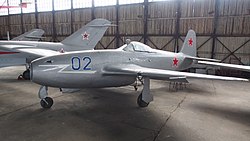Jakowlev Jak-17
| Jakowlev Jak-17 | |
|---|---|

|
|
| Type: | Fighter plane |
| Design country: | |
| Manufacturer: | |
| First flight: |
June 12, 1947 |
| Production time: |
1947 to 1948 |
| Number of pieces: |
430 |
The Yakovlev Yak-17 ( Russian Яковлев Як-17 , NATO reporting name Type 16 , later Feather ) is among the first in the Soviet Union in series-built jet fighters .
development
The Jak-17 was the successor to the Jak-15 , which in turn was an alternative to the MiG-9 .
The visually visible difference to the Jak-15 was in the landing gear, which had a bow instead of a stern wheel. Since the RD-10A engine used, which was derived from the Junkers Jumo 004 , filled the entire bow section, the nose wheel was housed in a teardrop-shaped bulge outside under the fuselage. In addition, the airframe was strengthened, the vertical stabilizer and the air intake enlarged .
The first prototype Jak-154 (or Jak-15U ) flew for the first time on June 12, 1947. In the same year series production began and by 1948 430 machines had been made.
The Jak-17 served only a short time in the Soviet air force , since it was only considered as a temporary solution . One example was tested in Czechoslovakia in 1949/50, where it was designated as the S-100 and a license was considered, but this was not realized. A license was also to be built in Poland, but this did not happen due to the great success of the MiG-15 .
The two-seat Jak-17UTI (also Jak-21T ), which was equipped with a double control and which flew for the first time in May 1947 , was developed for training purposes . This version was also used in China. The NATO code name for this version was Type 26 , later Magnet .
The next further developments of the Jak jet fighter series were the Jak-19 and the Jak-23, which were also built in series . The last machine, Jak-23, flew until 1961 for test purposes at the Polish Aviation Institute.
technical description
The Jak-17 was a cantilevered middle-decker in a wood / metal composite construction with a cantilevered structure. Two additional drop tanks could be attached to the wing ends to increase the range .
Technical specifications
| Parameter | Data |
|---|---|
| crew | 1 |
| span | 9.20 m |
| length | 8.78 m |
| height | 2.90 m |
| Wing area | 14.80 m² |
| Empty mass | 2430 kg |
| Takeoff mass | normal 2890 kg max. 3323 kg with additional tanks |
| Engine | an RD-10A turbine air jet engine |
| power | Starting thrust 9.8 kN |
| Top speed | 650 km / h near the ground, 751 km / h at 5000 m altitude |
| Summit height | 12,750 m |
| Climb performance | Max. 4.2 m / s |
| Rise time | 5.8 min at 5000 m altitude |
| Range | 710 km with additional tanks |
| Armament | two rigid 23 mm automatic cannon NS-23 in the nose section |
See also
Web links
Individual evidence
- ↑ Wilfried Bergholz: Russian fighter planes since 1934. Motorbuch, Stuttgart 2019, ISBN 978-3-613-04226-1 , p. 80
- ↑ Vaclav Nemecek: Československá letadla . Naše Vojsko, Prague 1968, p. 187 (Czech).
- ↑ Yakovlev Yak-23 , plane-encyclopedia
